Energy-Efficient Mixtures Suitable for 3D Technologies
Abstract
:1. Introduction
2. Materials and Methods
3. Results and Discussion
4. Conclusions
- In this paper, we investigated the comparative effect of dispersed mineral products of technogenic origin on the properties of mixtures suitable for 3D printing.
- A comparison was made of the test results of the properties of samples printed on a 3D printer with samples made according to the same recipes on a vibrating platform.
- The initial setting time or “printing window” is most significant when using limestone. The smallest initial setting time observed for the slag–alkaline binder.
- The structural strength of mixtures for 3D printers 20 and 40 min after mixing is the highest when using limestone and slag–alkaline binder, respectively, and the lowest when using fly ash.
- The highest values of bending, splitting, and compressive strength were obtained when using fly ash and blast furnace granulated slag, and the lowest for the slag–alkaline binder.
- Samples of the same material composition made on a vibrating platform have slightly higher compressive strength than those made using a 3D printer, which is explained by the lack of compaction of the mixtures. The slightest drop in strength is shown when using fly ash.
- Compensation for insufficient compaction of mixtures on a 3D printer is possible due to the introduction of additives of a hardening activator, NaOH (up to 4% of the binder weight), and superplasticizers (0.2…0.5%) into the composition of such concretes, as well as with their complex use.
- Use of industrial waste in 3D printing should help to manage waste that occurs locally, i.e., waste that does not require the transport of ingredients, or this transport will be significantly limited. Therefore, it is important to adjust the composition and design mixtures appropriate for local waste sources.
Author Contributions
Funding
Data Availability Statement
Acknowledgments
Conflicts of Interest
References
- Perrot, A.; Rangeard, D.; Courteille, E. 3D Printing of Earth-Based Materials: Processing Aspects. Constr. Build. Mater. 2018, 172, 670–676. [Google Scholar] [CrossRef]
- Ali, M.H.; Issayev, G.; Shehab, E.; Sarfraz, S. A Critical Review of 3D Printing and Digital Manufacturing in Construction Engineering. Rapid Prototyp. J. 2022, 28, 1312–1324. [Google Scholar] [CrossRef]
- Wang, B.; Zhai, M.; Yao, X.; Wu, Q.; Yang, M.; Wang, X.; Huang, J.; Zhao, H. Printable and Mechanical Performance of 3D Printed Concrete Employing Multiple Industrial Wastes. Buildings 2022, 12, 374. [Google Scholar] [CrossRef]
- Dvorkin, L.; Marchuk, V.; Hager, I.; Maroszek, M. Design of Cement–Slag Concrete Composition for 3D Printing. Energies 2022, 15, 4610. [Google Scholar] [CrossRef]
- Wu, Y.; Liu, C.; Bai, G.; Liu, H.; Meng, Y.; Wang, Z. 3D Printed Concrete with Recycled Sand: Pore Structures and Triaxial Compression Properties. Cem. Concr. Compos. 2023, 139, 105048. [Google Scholar] [CrossRef]
- Chen, Y.; Chaves Figueiredo, S.; Li, Z.; Chang, Z.; Jansen, K.; Çopuroğlu, O.; Schlangen, E. Improving Printability of Limestone-Calcined Clay-Based Cementitious Materials by Using Viscosity-Modifying Admixture. Cem. Concr. Res. 2020, 132, 106040. [Google Scholar] [CrossRef]
- Chen, Y.; Veer, F.; Çopuroğlu, O. A Critical Review of 3D Concrete Printing as a Low CO2 Concrete Approach. Heron 2017, 62, 167–194. [Google Scholar]
- Chen, Y.; Veer, F.; Copuroglu, O.; Schlangen, E. Feasibility of Using Low CO2 Concrete Alternatives in Extrusion-Based 3D Concrete Printing. In RILEM Bookseries; Springer: Berlin/Heidelberg, Germany, 2019; Volume 19. [Google Scholar]
- Chen, Y.; Li, Z.; Figueiredo, S.C.; Çopuroğlu, O.; Veer, F.; Schlangen, E. Limestone and Calcined Clay-Based Sustainable Cementitious Materials for 3D Concrete Printing: A Fundamental Study of Extrudability and Early-Age Strength Development. Appl. Sci. 2019, 9, 1809. [Google Scholar] [CrossRef]
- Panda, B.; Unluer, C.; Tan, M.J. Investigation of the Rheology and Strength of Geopolymer Mixtures for Extrusion-Based 3D Printing. Cem. Concr. Compos. 2018, 94, 307–314. [Google Scholar] [CrossRef]
- Bentz, D.P.; Stutzman, P.E.; Zunino, F. Low-Temperature Curing Strength Enhancement in Cement-Based Materials Containing Limestone Powder. Mater. Struct. 2017, 50, 551. [Google Scholar] [CrossRef]
- Sanytsky, M.; Marushchak, U.; Olevych, Y.; Novytskyi, Y. Nano-Modified Ultra-Rapid Hardening Portland Cement Compositions for High Strength Concretes. In Lecture Notes in Civil Engineering; Springer: Berlin/Heidelberg, Germany, 2020; Volume 47. [Google Scholar]
- Juenger, M.C.G.; Siddique, R. Recent Advances in Understanding the Role of Supplementary Cementitious Materials in Concrete. Cem. Concr. Res. 2015, 78, 71–80. [Google Scholar] [CrossRef]
- Lothenbach, B.; Scrivener, K.; Hooton, R.D. Supplementary Cementitious Materials. Cem. Concr. Res. 2011, 41, 1244–1256. [Google Scholar] [CrossRef]
- Nerella, V.N.; Näther, M.; Iqbal, A.; Butler, M.; Mechtcherine, V. Inline Quantification of Extrudability of Cementitious Materials for Digital Construction. Cem. Concr. Compos. 2019, 95, 260–270. [Google Scholar] [CrossRef]
- Chaves Figueiredo, S.; Romero Rodríguez, C.; Ahmed, Z.Y.; Bos, D.H.; Xu, Y.; Salet, T.M.; Çopuroğlu, O.; Schlangen, E.; Bos, F.P. An Approach to Develop Printable Strain Hardening Cementitious Composites. Mater. Des. 2019, 169, 107651. [Google Scholar] [CrossRef]
- Le, T.T.; Austin, S.A.; Lim, S.; Buswell, R.A.; Gibb, A.G.F.; Thorpe, T. Mix Design and Fresh Properties for High-Performance Printing Concrete. Mater. Struct. 2012, 45, 1221–1232. [Google Scholar] [CrossRef]
- Ma, G.; Li, Z.; Wang, L. Printable Properties of Cementitious Material Containing Copper Tailings for Extrusion Based 3D Printing. Constr. Build. Mater. 2018, 162, 613–627. [Google Scholar] [CrossRef]
- Panda, B.; Ruan, S.; Unluer, C.; Tan, M.J. Improving the 3D Printability of High Volume Fly Ash Mixtures via the Use of Nano Attapulgite Clay. Compos. B Eng. 2019, 165, 75–83. [Google Scholar] [CrossRef]
- Dvorkin, L.; Zhitkovsky, V.; Sonebi, M.; Marchuk, V.; Stepasiuk, Y. Improving Concrete and Mortar Using Modified Ash and Slag Cements; CRC Press: Boca Raton, FL, USA, 2020. [Google Scholar]
- Sanjayan, J.; Nematollahi, B.; Xia, M.; Wang, L.; Guowei, M. 3D Concrete Printing with Low Carbon Cements; Butterworth-Heinemann: Oxford, UK, 2019; 416p. [Google Scholar]
- De Weerdt, K.; Kjellsen, K.O.; Sellevold, E.; Justnes, H. Synergy between Fly Ash and Limestone Powder in Ternary Cements. Cem. Concr. Compos. 2011, 33, 30–38. [Google Scholar] [CrossRef]
- Prokopski, G.; Marchuk, V.; Huts, A. The Effect of Using Granite Dust as a Component of Concrete Mixture. Case Stud. Constr. Mater. 2020, 13, e00349. [Google Scholar] [CrossRef]
- Dobiszewska, M.; Franus, W.; Turbiak, S. Analysis of the Possibility of Using Powder Basalt in Cement Mortar. J. Civ. Eng. Environ. Archit. 2016, 63, 107–114. [Google Scholar]
- Berodier, E.; Scrivener, K. Understanding the Filler Effect on the Nucleation and Growth of C-S-H. J. Am. Ceram. Soc. 2014, 97, 3764–3773. [Google Scholar] [CrossRef]
- Přikryl, R.; Török, Á.; Theodoridou, M.; Gomez-Heras, M.; Miskovsky, K. Geomaterials in Construction and Their Sustainability: Understanding Their Role in Modern Society. Geol. Soc. Spec. Publ. 2016, 416, 1–22. [Google Scholar] [CrossRef]
- Krivenko, P. Why Alkaline Activation—60 Years of the Theory and Practice of Alkali-Activated Materials. J. Ceram. Sci. Technol. 2017, 8, 323–334. [Google Scholar]
- Flatt, R.J.; Wangler, T. On Sustainability and Digital Fabrication with Concrete. Cem. Concr. Res. 2022, 158, 106837. [Google Scholar] [CrossRef]
- Kazemian, A.; Yuan, X.; Cochran, E.; Khoshnevis, B. Cementitious Materials for Construction-Scale 3D Printing: Laboratory Testing of Fresh Printing Mixture. Constr. Build. Mater. 2017, 145, 639–647. [Google Scholar] [CrossRef]
- Tay, Y.W.D.; Ting, G.H.A.; Qian, Y.; Panda, B.; He, L.; Tan, M.J. Time Gap Effect on Bond Strength of 3D-Printed Concrete. Virtual Phys. Prototyp. 2019, 14, 104–113. [Google Scholar] [CrossRef]
- Nerella, V.N.; Krause, M.; Mechtcherine, V. Direct Printing Test for Buildability of 3D-Printable Concrete Considering Economic Viability. Autom. Constr. 2020, 109, 102986. [Google Scholar] [CrossRef]
- Rushing, T.S.; Stynoski, P.B.; Barna, L.A.; Al-Chaar, G.K.; Burroughs, J.F.; Shannon, J.D.; Kreiger, M.A.; Case, M.P. Investigation of Concrete Mixtures for Additive Construction. In 3D Concrete Printing Technology; Elsevier: Amsterdam, The Netherlands, 2019; pp. 137–160. [Google Scholar]
- Mechtcherine, V.; Nerella, V.N.; Will, F.; Näther, M.; Otto, J.; Krause, M. Large-Scale Digital Concrete Construction—CONPrint3D Concept for on-Site, Monolithic 3D-Printing. Autom. Constr. 2019, 107, 102933. [Google Scholar] [CrossRef]
- Gosselin, C.; Duballet, R.; Roux, P.; Gaudillière, N.; Dirrenberger, J.; Morel, P. Large-Scale 3D Printing of Ultra-High Performance Concrete—A New Processing Route for Architects and Builders. Mater. Des. 2016, 100, 102–109. [Google Scholar] [CrossRef]
- Anton, A.; Reiter, L.; Wangler, T.; Frangez, V.; Flatt, R.J.; Dillenburger, B. A 3D Concrete Printing Prefabrication Platform for Bespoke Columns. Autom. Constr. 2021, 122, 103467. [Google Scholar] [CrossRef]
- Boscaro, F.; Quadranti, E.; Wangler, T.; Mantellato, S.; Reiter, L.; Flatt, R.J. Eco-Friendly, Set-on-Demand Digital Concrete. 3D Print. Addit. Manuf. 2022, 9, 3–11. [Google Scholar] [CrossRef] [PubMed]
- Hager, I.; Maroszek, M.; Mróz, K.; Kęsek, R.; Hebda, M.; Dvorkin, L.; Marchuk, V. Interlayer Bond Strength Testing in 3D-Printed Mineral Materials for Construction Applications. Materials 2022, 15, 4112. [Google Scholar] [CrossRef] [PubMed]
- IEA; UNEP. 2022 Building Construction Global Status Report; IEA: Paris, France; UNEP: Nairobi, Kenya, 2022; Volume 224. [Google Scholar]
- Sanytsky, M.; Sobol, H.; Markiv, M. Modified Cement Composites; NU “Lviv Polytechnic: Lviv, Ukraine, 2010. (In Ukrainian) [Google Scholar]
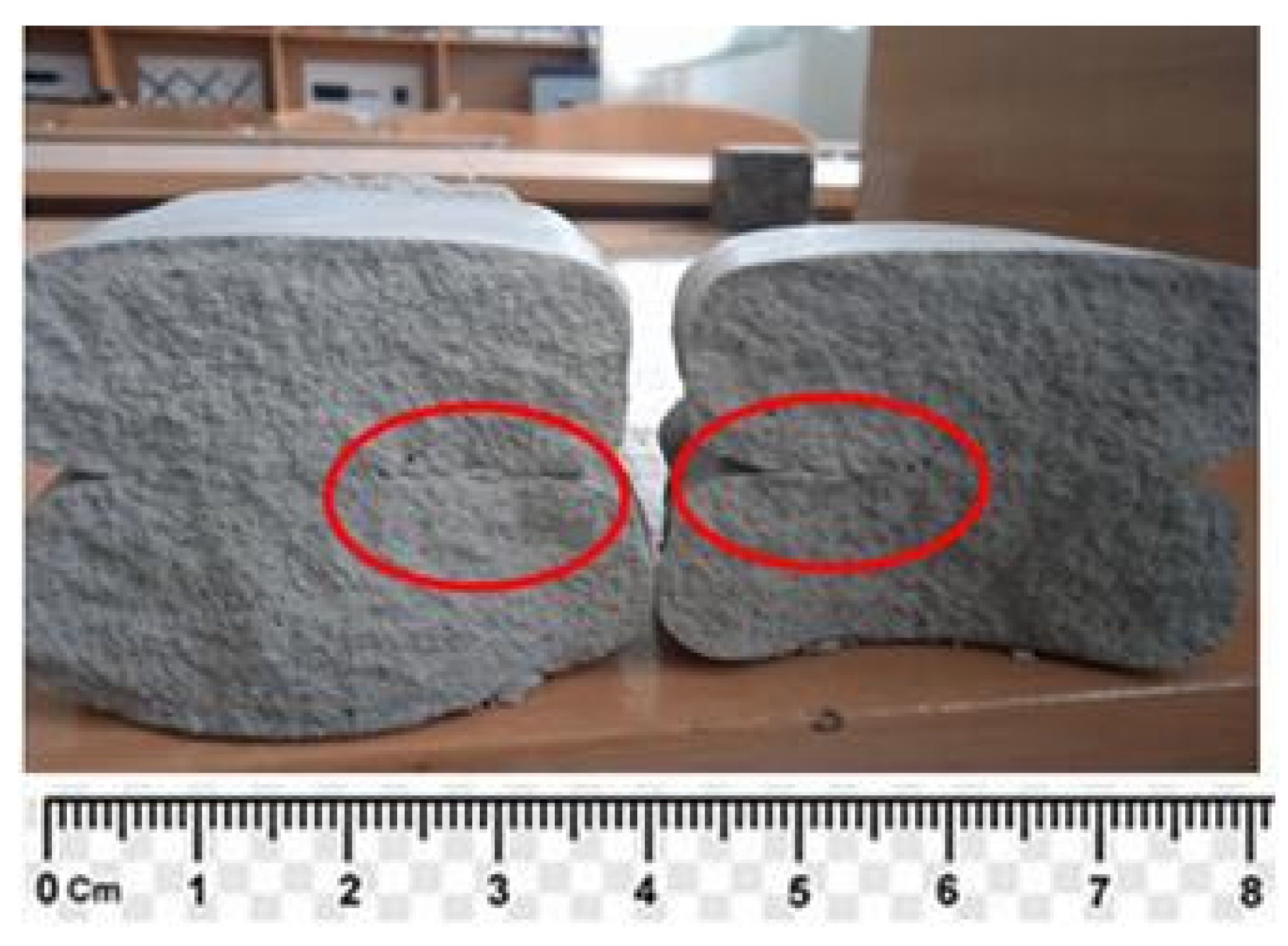

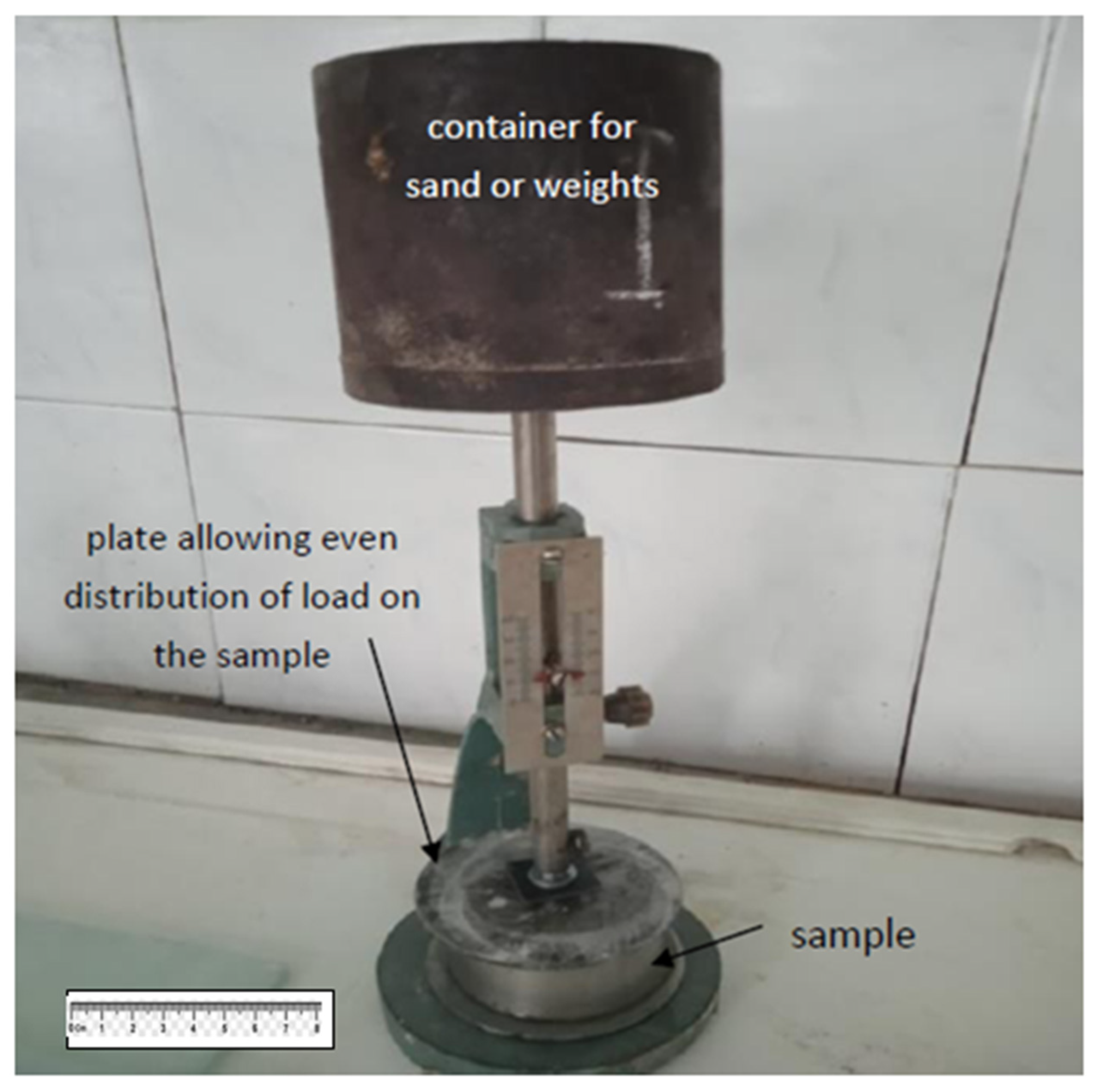



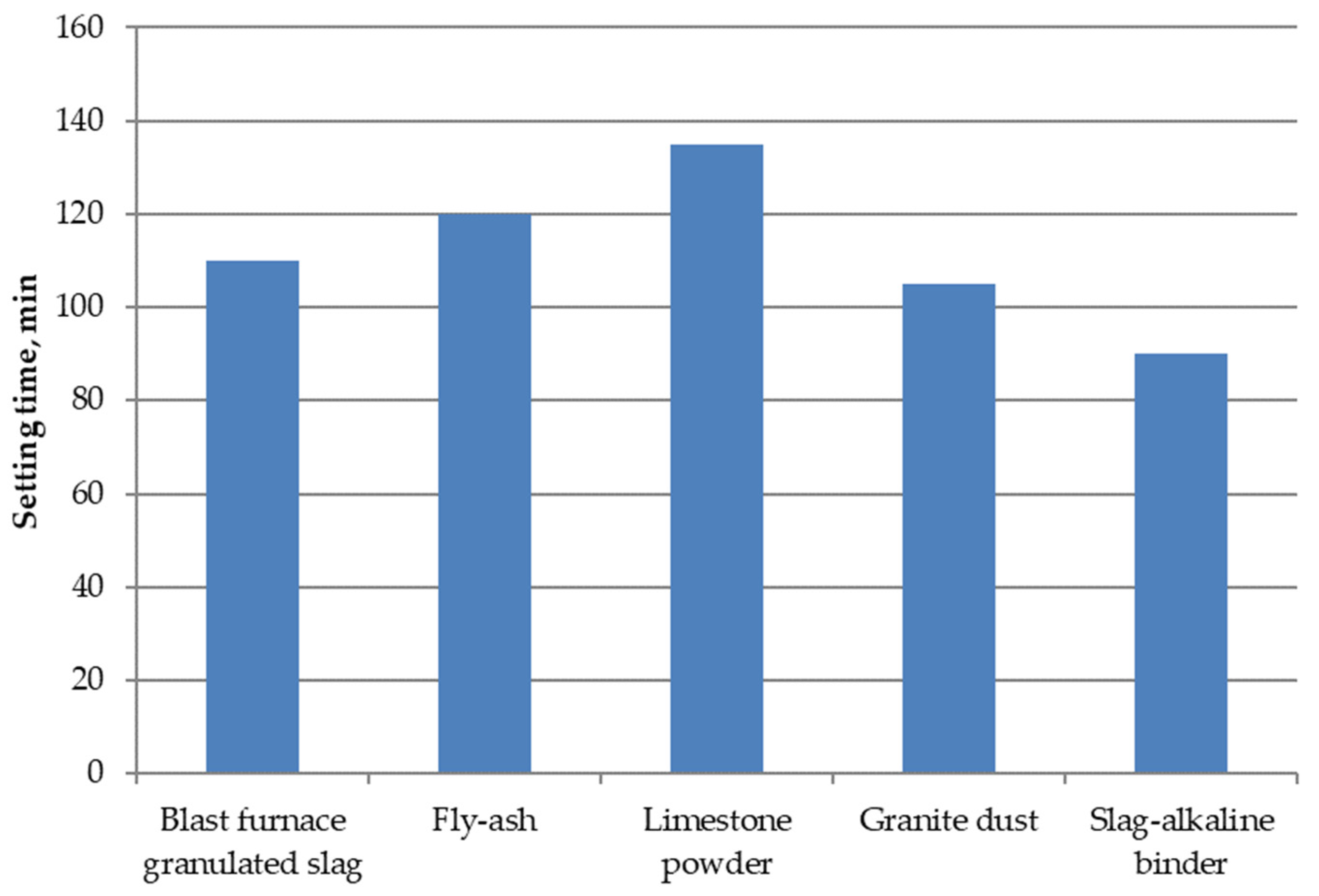

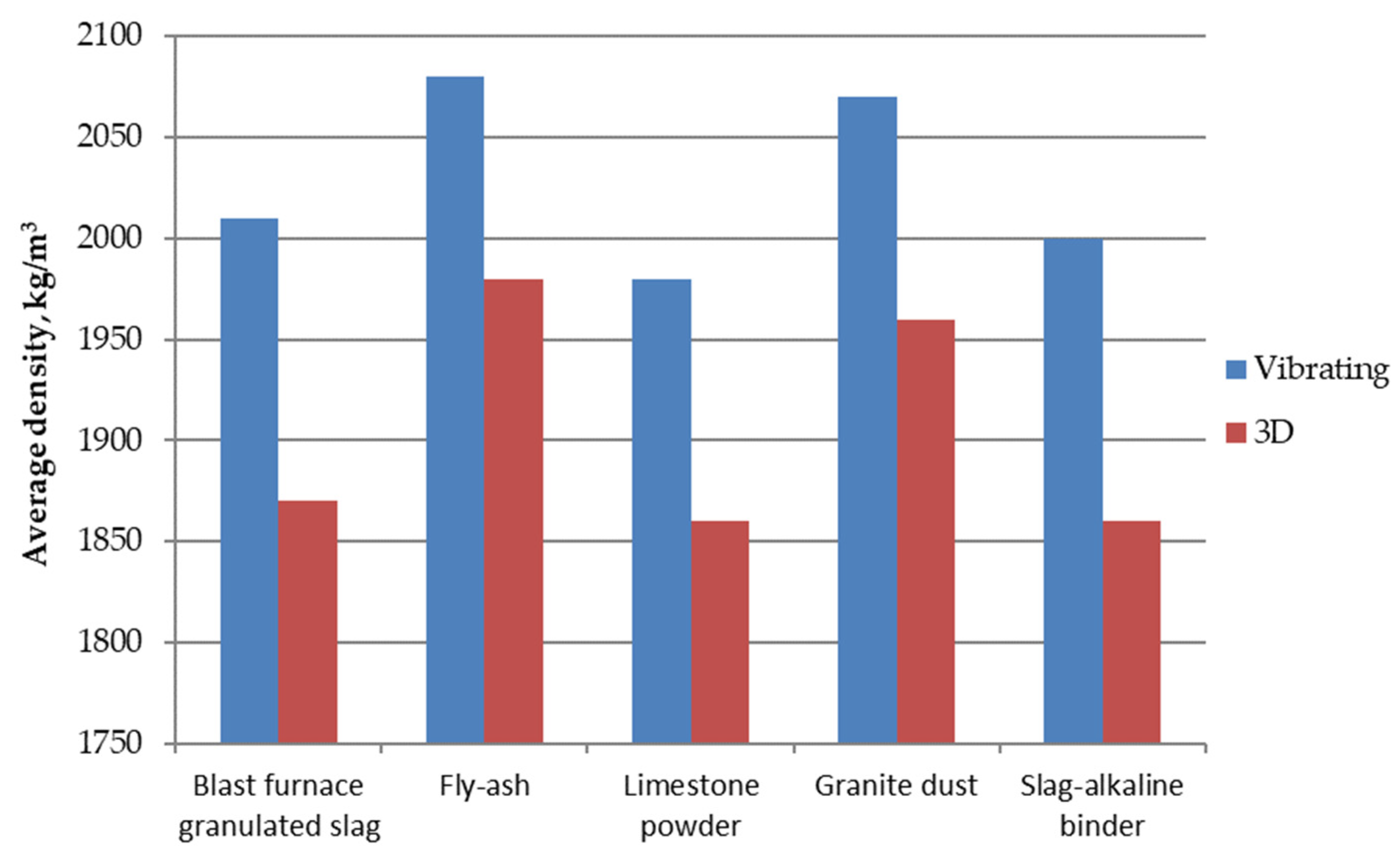
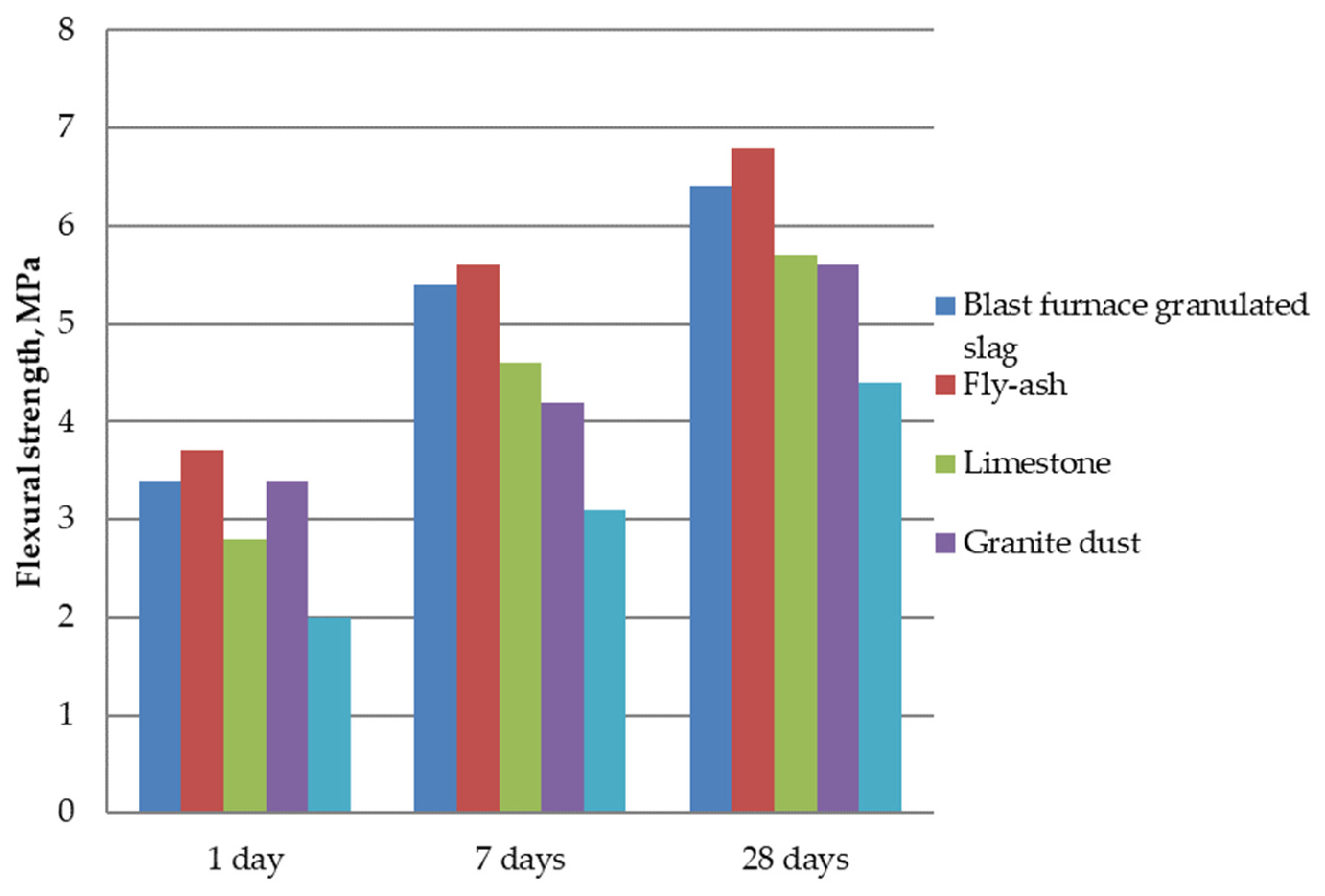
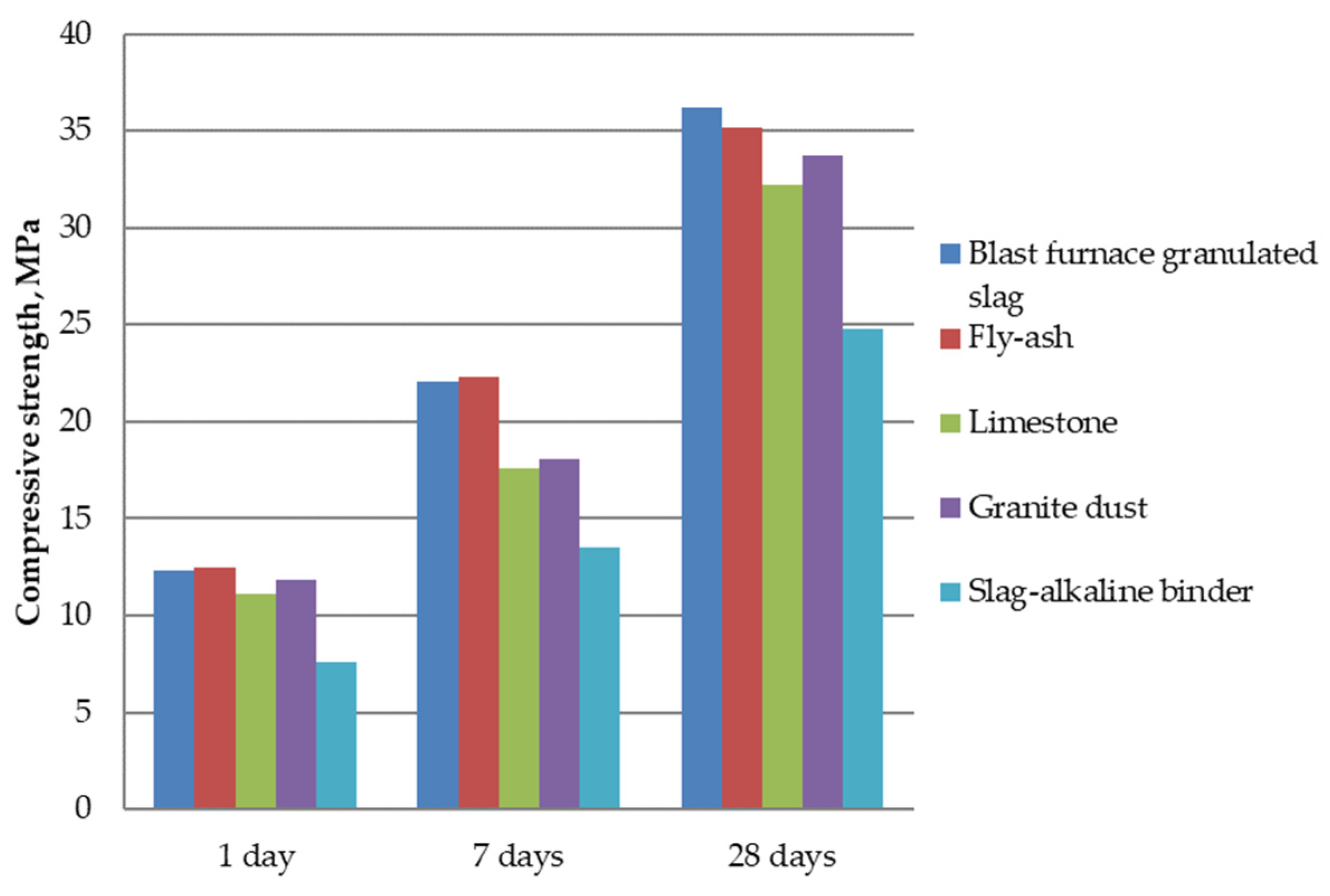

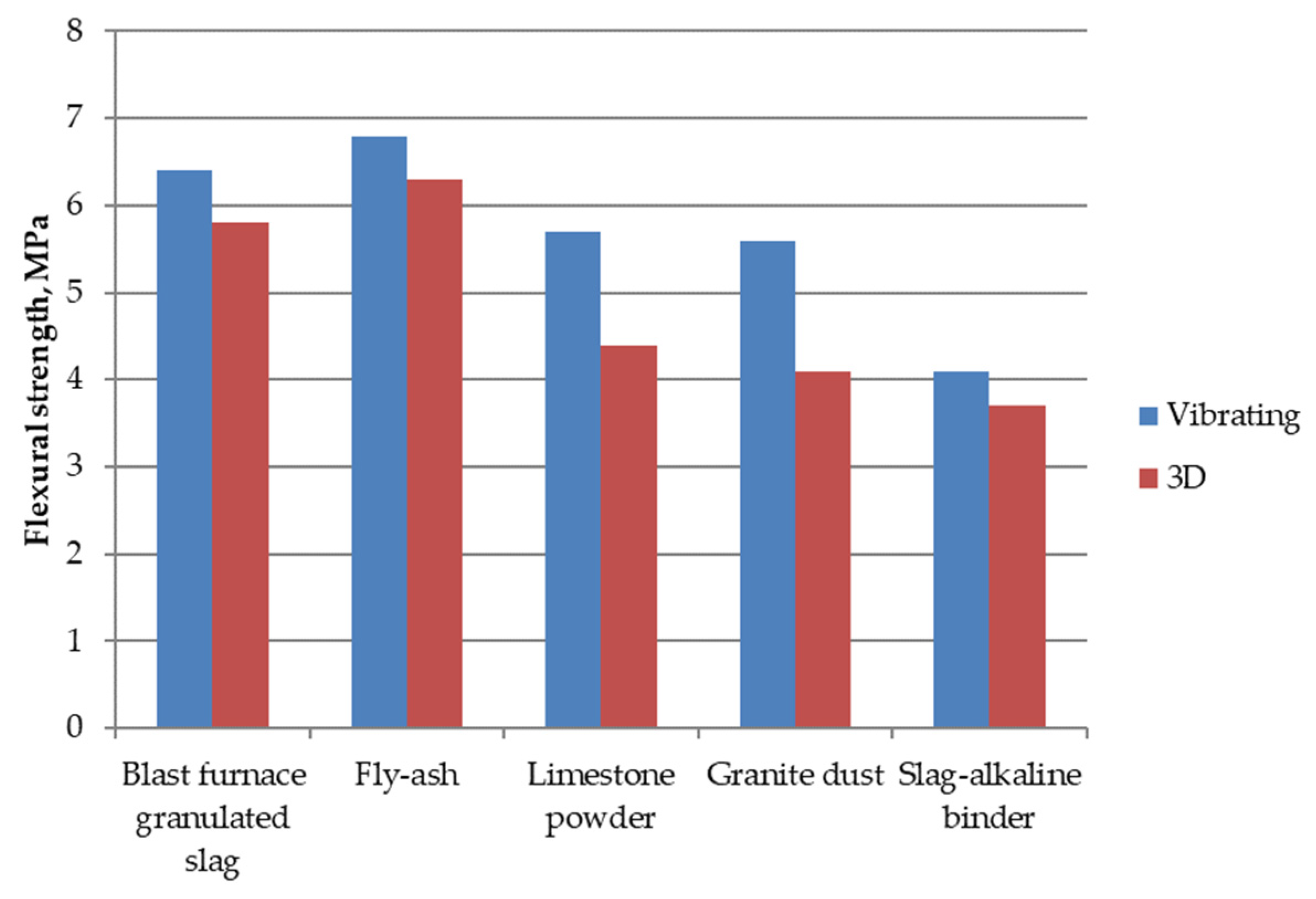



| Concrete Type/Study Authors | Water-Binder Ratio w/b | Consumption of Cement, kg/m3 | Paste Volume, L/m3 | Cement Substitution Additives, % | Maximum Aggregate Size. Dmax, mm | |
|---|---|---|---|---|---|---|
| Standard concretes | Normal | 0.60 | ~250 | ~275 | ~20 | 32 |
| Concrete masonry unit | 0.65 | ~180–250 | ~240 | ~20 | 10 | |
| Infrastructure | 0.42 | ~350 | ~325 | ~20 | 32 | |
| High performance | 0.35 | ~400–450 | ~375 | ~20 | 8–16 | |
| Digital concrete–1K | Le et al. [17] | 0.28 | 579 | 532 | 30 | 2 |
| Kazemian et al. [29] | 0.43 | 540 | 489 | 10 | 4.75 | |
| Tay et al. [30] | 0.46 | 558 | 639 | 30 | 2 | |
| Nerella et al. [31] | 0.33 | 391 | 525 | 45 | 2 | |
| Chen et al. [6] | 0.30 | 331 | 532 | 60 | 1 | |
| Rushing et al. [32] | 0.44 | 419 | 437 | 10 | 9.5 | |
| Mechtcherine et al. [33] | 0.30 | 350 | 438 | 41 | 8 | |
| Digital concrete–2K | Gosselin et al. [34] | 0.23 | 800 | 612 | 18 | <1 |
| Anton et al. [35] | 0.42 | 540 | 530 | 23 | 2 | |
| Boscaro et al. [36] | 0.45 | 303 | 476 | 50 | 2 |
| Name Material | L.O.I. | Oxide Content, % | |||||
|---|---|---|---|---|---|---|---|
| SiO2 | Al2O3 | Fe2O3 | CaO | MgO | SO3 | ||
| Clinker * | - | 21.80 | 5.32 | 4.11 | 66.80 | 0.95 | 0.63 |
| Blast-furnace slag | 0.59 | 39.51 | 6.47 | 0.14 | 47.19 | 3.12 | 1.76 |
| Fly ash | 5.1 | 46.1 | 18.1 | 22.1 | 2.1 | 2.0 | 2.3 |
| Granite dust | - | 64.8 | 15.6 | 6.31 | 2.59 | 0.33 | 0.11 |
| Limestone | 43.8 | 0.29 | 0.40 | 0.11 | 54.40 | 0.40 | 0.08 |
| No. | Type of Mineral Additive | Content of Components, kg/m3 | |||
|---|---|---|---|---|---|
| PC Portland Cement | Mineral Additive | Sand | Water | ||
| 1 | Blast furnace granulated slag | 250 | 250 | 1440 | 290 |
| 2 | Fly ash | 300 | 200 | 1495 | 270 |
| 3 | Limestone powder | 300 | 200 | 1495 | 270 |
| 4 | Granite dust | 350 | 150 | 1480 | 275 |
| 5 | Slag–alkaline binder * | 50 | 450 | 1348 | 295 |
| No. | Type of Mineral Additive | Content of Components, kg/m3 | Initial Setting Time, min | Structural Strength after 20 min, Pa | Compressive Strength at the Age of 1 Day, MPa | |||
|---|---|---|---|---|---|---|---|---|
| PC | Mineral Additive | Sand | Water | |||||
| 1 | – | 500 | – | 1534 | 260 | 105 | 4830 | 18.7 |
| 2 | Blast furnace granulated slag | 250 | 250 | 1440 | 290 | 110 | 4510 | 12.3 |
| 3 | 300 | 200 | 1470 | 280 | 110 | 4630 | 14.4 | |
| 4 | 350 | 150 | 1485 | 275 | 105 | 4720 | 16.1 | |
| 5 | Fly ash | 250 | 250 | 1480 | 275 | 120 | 4380 | 10.4 |
| 6 | 300 | 200 | 1495 | 270 | 120 | 4520 | 12.5 | |
| 7 | 350 | 150 | 1510 | 265 | 115 | 4630 | 14.8 | |
| 8 | Limestone powder | 250 | 250 | 1383 | 305 | 140 | 4410 | 8.2 |
| 9 | 300 | 200 | 1416 | 295 | 135 | 4600 | 11.1 | |
| 10 | 350 | 150 | 1448 | 285 | 130 | 4630 | 13.4 | |
| 11 | Granite dust | 250 | 250 | 1444 | 285 | 110 | 4210 | 6.8 |
| 12 | 300 | 200 | 1462 | 280 | 105 | 4380 | 9.1 | |
| 13 | 350 | 150 | 1480 | 275 | 105 | 4540 | 11.8 | |
| 14 | Slag–alkaline binder | 50 | 450 | 1350 | 295 | 90 | 4530 | 7.6 |
| No. | Type of Mineral Additive | Workability, mm | Initial Setting Time, min | Structural Strength, Pa | |
|---|---|---|---|---|---|
| after 20 min | after 40 min | ||||
| 1 | Blast furnace granulated slag | 170 | 110 | 4510 | 8475 |
| 2 | Fly ash | 155 | 120 | 4520 | 8200 |
| 3 | Limestone powder | 180 | 135 | 4600 | 8880 |
| 4 | Granite dust | 172 | 105 | 4540 | 8710 |
| 5 | Slag–alkaline binder | 168 | 90 | 4530 | 9120 |
| No. | Type of Mineral Additive | Mineral Additive Content, kg/m3 | Density kg/m3 | Tensile Strength at the Age of Days | Bending Strength at Age, Days, MPa | Compressive Strength at Age, Days, MPa | Density, kg/m3 | Bending Strength, MPa | Split Strength, MPa | Compressive Strength, MPa | ||||
|---|---|---|---|---|---|---|---|---|---|---|---|---|---|---|
| 28 | 1 | 7 | 28 | 1 | 7 | 28 | At the Age of 28 Days | |||||||
| Vibroplatform | 3D Printer | |||||||||||||
| 1 | Blast furnace granulated slag | 250 | 2010 | 4.1 | 3.4 | 5.4 | 6.4 | 12.3 | 22.1 | 36.2 | 1870 | 5.8 | 3.9 | 32.2 |
| 2 | Fly ash | 200 | 2080 | 4.4 | 3.7 | 5.6 | 6.8 | 12.5 | 22.3 | 35.2 | 1980 | 6.3 | 4.8 | 33.8 |
| 3 | Limestone powder | 200 | 1980 | 3.8 | 2.8 | 4.6 | 5.7 | 11.1 | 17.6 | 32.2 | 1860 | 4.4 | 3.6 | 28.8 |
| 4 | Granite dust | 150 | 2070 | 3.7 | 3.4 | 4.2 | 5.6 | 11.8 | 18.1 | 33.7 | 1960 | 4.1 | 3.3 | 30.1 |
| 5 | Slag–alkaline binder | - | 2000 | 3.2 | 2.0 | 3.1 | 4.4 | 7.6 | 13.5 | 24.8 | 1860 | 3.7 | 3.1 | 21.5 |
| No. | Type of Mineral Additive | Mineral Additive Content, kg/m3 | Activator (NaOH) Content, kg/m3 | SP Superplasticizer Content, kg/m3 | Bending Strength | Split Strength | Compressive Strength | Bending Strength | Split Strength | Compressive Strength |
|---|---|---|---|---|---|---|---|---|---|---|
| At the Age of 28 Days | At the Age of 28 Days | |||||||||
| Vibroplatform | 3D Printer | |||||||||
| 1 | Blast furnace granulated slag | 250 | 20 | 1.5 | 8.4 | 6.1 | 51.2 | 8.4 | 6.0 | 51.0 |
| 2 | Fly ash | 200 | 20 | - | 7.3 | 5.2 | 43.6 | 7.3 | 5.3 | 43.8 |
| 3 | Limestone powder | 200 | - | 1.8 | 5.7 | 4.5 | 38.2 | 5.4 | 4.6 | 38.0 |
| 4 | Granite dust | 150 | - | 1.5 | 6.0 | 4.7 | 40.7 | 6.1 | 4.8 | 41.1 |
Disclaimer/Publisher’s Note: The statements, opinions and data contained in all publications are solely those of the individual author(s) and contributor(s) and not of MDPI and/or the editor(s). MDPI and/or the editor(s) disclaim responsibility for any injury to people or property resulting from any ideas, methods, instructions or products referred to in the content. |
© 2024 by the authors. Licensee MDPI, Basel, Switzerland. This article is an open access article distributed under the terms and conditions of the Creative Commons Attribution (CC BY) license (https://creativecommons.org/licenses/by/4.0/).
Share and Cite
Dvorkin, L.; Marchuk, V.; Mróz, K.; Maroszek, M.; Hager, I. Energy-Efficient Mixtures Suitable for 3D Technologies. Appl. Sci. 2024, 14, 3038. https://doi.org/10.3390/app14073038
Dvorkin L, Marchuk V, Mróz K, Maroszek M, Hager I. Energy-Efficient Mixtures Suitable for 3D Technologies. Applied Sciences. 2024; 14(7):3038. https://doi.org/10.3390/app14073038
Chicago/Turabian StyleDvorkin, Leonid, Vitaliy Marchuk, Katarzyna Mróz, Marcin Maroszek, and Izabela Hager. 2024. "Energy-Efficient Mixtures Suitable for 3D Technologies" Applied Sciences 14, no. 7: 3038. https://doi.org/10.3390/app14073038






